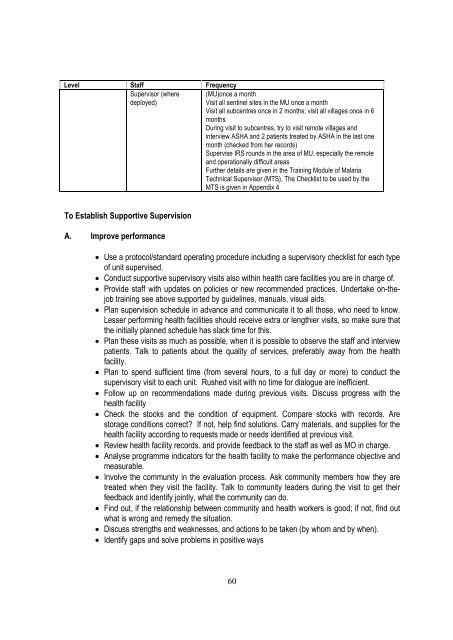training module for medical officers primary health centre - NVBDCP
training module for medical officers primary health centre - NVBDCP
training module for medical officers primary health centre - NVBDCP
- No tags were found...
Create successful ePaper yourself
Turn your PDF publications into a flip-book with our unique Google optimized e-Paper software.
Level Staff FrequencySupervisor (wheredeployed)(MU)once a monthVisit all sentinel sites in the MU once a monthVisit all sub<strong>centre</strong>s once in 2 months; visit all villages once in 6monthsDuring visit to sub<strong>centre</strong>s, try to visit remote villages andinterview ASHA and 2 patients treated by ASHA in the last onemonth (checked from her records)Supervise IRS rounds in the area of MU, especially the remoteand operationally difficult areasFurther details are given in the Training Module of MalariaTechnical Supervisor (MTS), The Checklist to be used by theMTS is given in Appendix 4To Establish Supportive SupervisionA. Improve per<strong>for</strong>mance Use a protocol/standard operating procedure including a supervisory checklist <strong>for</strong> each typeof unit supervised. Conduct supportive supervisory visits also within <strong>health</strong> care facilities you are in charge of. Provide staff with updates on policies or new recommended practices. Undertake on-thejob<strong>training</strong> see above supported by guidelines, manuals, visual aids. Plan supervision schedule in advance and communicate it to all those, who need to know.Lesser per<strong>for</strong>ming <strong>health</strong> facilities should receive extra or lengthier visits, so make sure thatthe initially planned schedule has slack time <strong>for</strong> this. Plan these visits as much as possible, when it is possible to observe the staff and interviewpatients. Talk to patients about the quality of services, preferably away from the <strong>health</strong>facility. Plan to spend sufficient time (from several hours, to a full day or more) to conduct thesupervisory visit to each unit. Rushed visit with no time <strong>for</strong> dialogue are inefficient. Follow up on recommendations made during previous visits. Discuss progress with the<strong>health</strong> facility Check the stocks and the condition of equipment. Compare stocks with records. Arestorage conditions correct? If not, help find solutions. Carry materials, and supplies <strong>for</strong> the<strong>health</strong> facility according to requests made or needs identified at previous visit. Review <strong>health</strong> facility records. and provide feedback to the staff as well as MO in charge. Analyse programme indicators <strong>for</strong> the <strong>health</strong> facility to make the per<strong>for</strong>mance objective andmeasurable. Involve the community in the evaluation process. Ask community members how they aretreated when they visit the facility. Talk to community leaders during the visit to get theirfeedback and identify jointly, what the community can do. Find out, if the relationship between community and <strong>health</strong> workers is good; if not, find outwhat is wrong and remedy the situation. Discuss strengths and weaknesses, and actions to be taken (by whom and by when). Identify gaps and solve problems in positive ways60
















